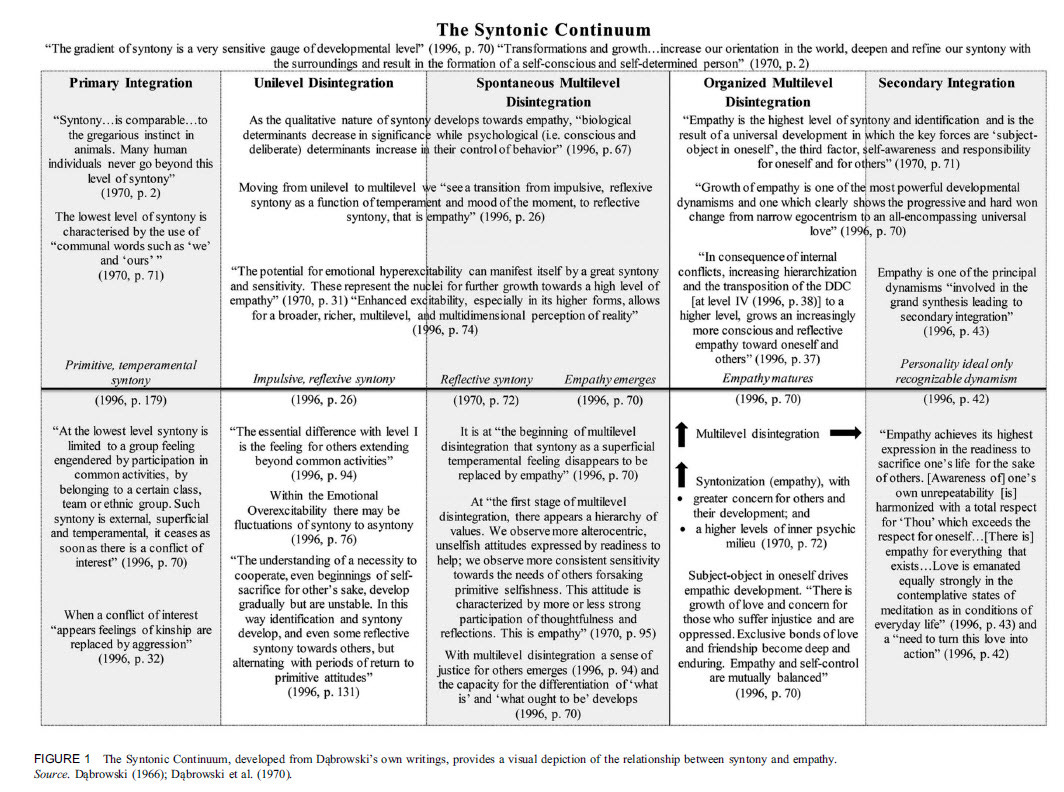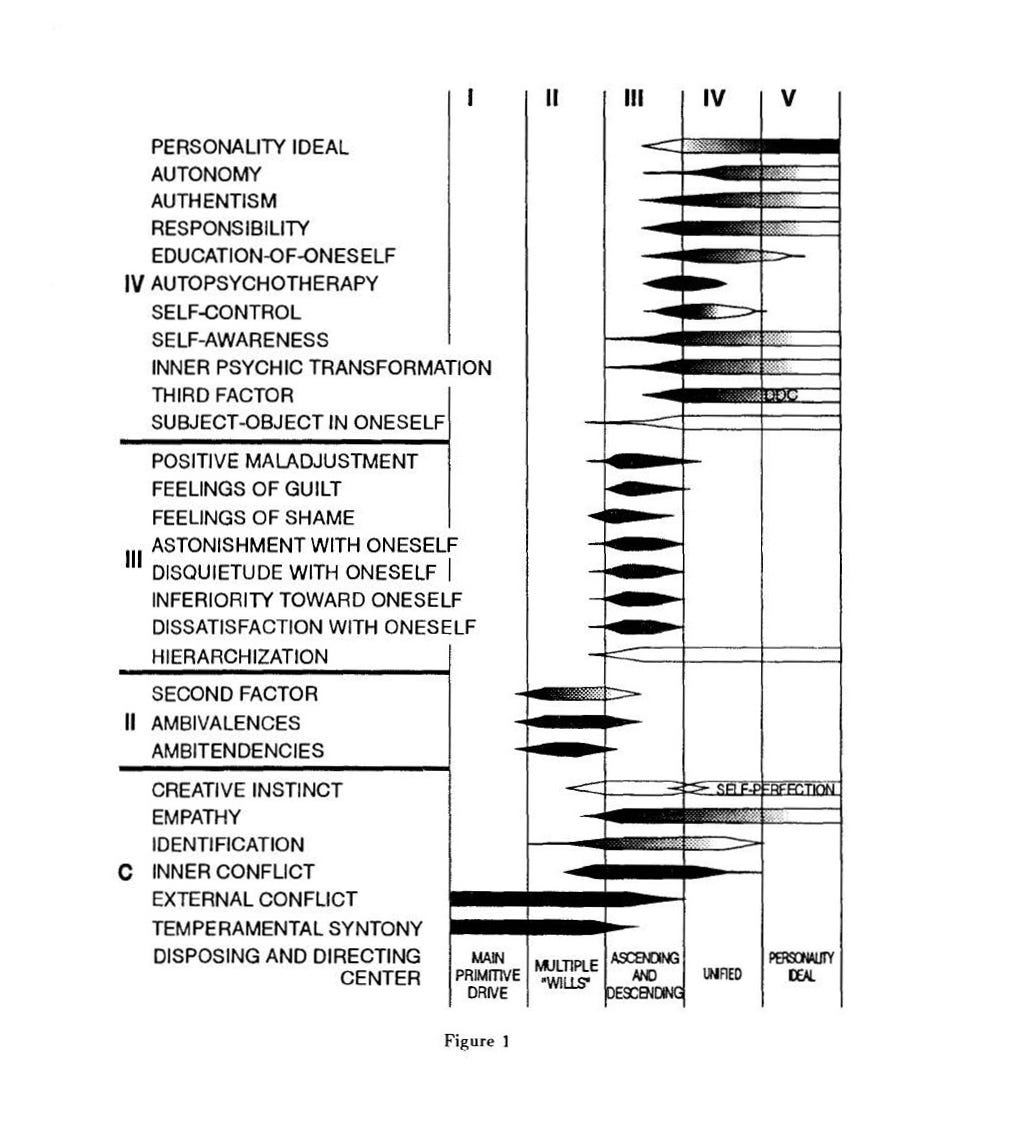In episode 13, Chris and Emma were joined by Dr. Amanda Harper, an educator and Dąbrowski scholar from Tasmania, Australia. We discussed the deep and fascinating work that Amanda has done in examining Dąbrowski’s writing. The focus was on two of her published papers: one on Empathy and the Syntonic Continuum, and the other on Philosophy, Faith, and the Personality Ideal.
We talk about the differences between syntony and empathy, how they look across various levels, and how Amanda mapped them in order to create a visual guide to these important dynamisms. We explore the value of defining terms, and why using Dabrowski’s own language and quotes helps us gain greater meaning from the theory of positive disintegration. Reading Dabrowski’s work can be a ‘treasure hunt’ for both academic purposes and within your own life!
Amanda shared what it was like to study the theory during her master’s and doctoral programs, and compared notes with Chris who also has experience examining constructs over time in Dąbrowski’s original texts, as well as the value and experience of attending conferences and meeting up with the Dabrowski community.
Resources mentioned during this episode
Jasneath Education (Amanda’s website with courses available for purchase)
Remember to check out Amanda’s newsletter.
The papers we mentioned:
Through the Dąbrowski Lens: Empathy and the Syntonic Continuum (2019)
Through the Dąbrowski Lens: Philosophy, Faith, and the Personality Ideal (2017)
Through the Dąbrowski Lens: A Fresh Examination of the Theory of Positive Disintegration (2017)
Amanda’s new chapter can be found in the Palgrave Handbook of Transformational Giftedness for Education:
Through the Dąbrowski Lens: Wisdom, Transformational Giftedness, and the Personality Ideal
The Dąbrowski original materials are available through Bill’s website.
*A transcript of this episode is available on our website.
The quotations we read during the episode:
“The term syntony is used within Dąbrowski’s writings to describe a sense of balance and oneness. This refers to a state where there is no inner turmoil and no conflict but there is a deep sense of connection and unification with existence in the world” (Harper & Clifford, 2019, p. 36).
“Empathy is a response based on reflection, a sense of nurturing toward other people, and an understanding of others’ circumstances (Dąbrowski, 1973)” (Harper & Clifford, 2019, p. 37).
“Growth of empathy is one of the most powerful developmental dynamics and one which most clearly shows the progressive and hard won change from narrow egocentrism to an all-encompassing universal love. Empathy grows out of the strong emotions of search for the meaning of life and finding it in concern and service to others, and out of the need for self-perfection as a human being. Self-perfection is not possible in a vacuum but grows out of a sense of relatedness with others measured in terms of an “ideal other” embodied in one’s personality ideal. It grows out of conflicts with oneself which produce an increase in caring and appreciation of others, and deeper humility within oneself.” (Dąbrowski, 1996, p. 70)
“Without the tragic, the challenging, the conflicting, and the confronting, an individual cannot—will not—experience the inner psychic transformation necessary for multilevel development or the emergence of a full empathic condition and cannot move toward the personality ideal. Similarly, without these challenges and anxieties, we are not equipped to understand or experience in its fullness the tapestry, elation, and fulfillment of the process of development.” (Harper & Clifford, 2019, p. 265)
Here are the graphic representations that were mentioned during the episode:
Amanda’s Syntonic Continuum from her 2019 paper:
The Constellations of Dynamisms figure that Chris mentioned pulling up during the discussion of syntony and empathy as “continuing dynamisms”:
This figure is from Dąbrowski (1996) and includes this description: Figure 1 shows that at each level of development there is a different constellation of factors. Roman numerals refer to levels, C refers to that category of factors whose operation extends over several levels of development. Dark shading indicates tension in the operation of a given factor. Tension abates toward higher levels of development. But there is one exception—personality ideal—the highest dynamism which increases in significance and power as development advances to higher levels. The spindle shapes are, meant to indicate the incipience and disappearance of a given factor. They reflect an expected frequency of responses identifiable as expression of a given factor. Thus, for instance, when the dynamisms of level III appear and gain ground, the three dynamisms of level II should disappear. (p. 32)
Connect with us!
Positive Disintegration on Substack
Visit the Dabrowski Center website
The Positive Disintegration YouTube Channel
Adults with Overexcitabilities group on Facebook
Dabrowski Center and Positive Disintegration Podcast Community on Facebook
The Tragic Gift blog by Emma
Email us at positivedisintegration.pod@gmail.com
Please consider supporting the podcast to help fund this work through the Dabrowski Center, a 501(c)(3) nonprofit organization.
Find Positive Disintegration Merch
If you enjoyed this episode on Apple or Spotify, please remember to click on the stars and leave a rating or write a review. Thank you! <3

















Through the Dąbrowski Lens